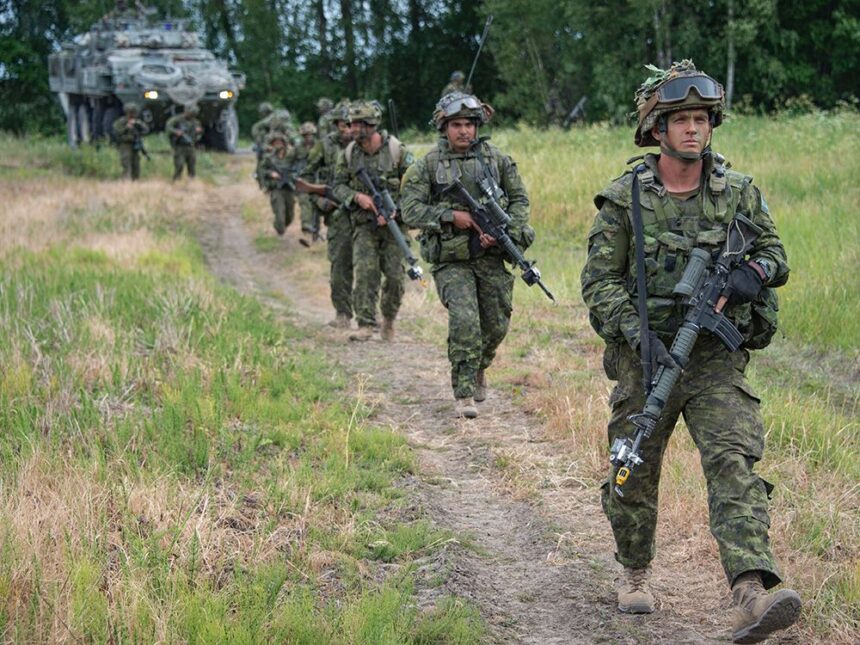The federal government’s claims of reaching NATO’s two percent defense spending target appear to be dissolving under scrutiny. Last month’s federal budget promised to hit this crucial alliance commitment, but military analysts warn Canada is calculating its way to compliance rather than actually meeting the standard.
“The numbers simply don’t add up when you examine them closely,” said David Perry, president of the Canadian Global Affairs Institute. “Canada is essentially shooting at a moving target by changing what counts toward defense spending rather than making substantial new investments.”
I’ve reviewed budget documents that show how Canada plans to reach the two percent threshold: by including previously uncounted expenses like Coast Guard operations, intelligence services, and even some border security costs. These accounting adjustments would push Canada’s reported defense spending from the current 1.33 percent to the NATO-mandated two percent.
NATO established this target at the 2014 Wales Summit following Russia’s annexation of Crimea. Alliance members committed to spending at least two percent of their GDP on defense by 2024. Ten years later, only 11 of NATO’s 32 members have reached this goal, according to the alliance’s most recent report.
Defense Minister Bill Blair defended the government’s approach when questioned in Parliament. “We are following the NATO guidance on what constitutes legitimate defense expenditures,” Blair stated. “These investments strengthen our collective security and meet our alliance obligations.”
However, NATO’s own spending guidelines don’t support this interpretation. The alliance’s defense expenditure criteria focus primarily on each country’s armed forces and military capability development. While NATO has allowed some flexibility in reporting, several experts caution that Canada’s approach stretches credibility.
Stephen Saideman, director of the Canadian Defence and Security Network at Carleton University, expressed skepticism about the government’s methodology. “If Canada reaches two percent by accounting tricks rather than actual increased military capacity, our allies will notice the difference,” Saideman told me during a recent interview. “The question isn’t just whether we can justify it on paper, but whether we’re genuinely strengthening our forces.”
This budgetary maneuver comes as Canada faces growing pressure from the United States and other allies to bolster its military commitments. Recent polling by the Angus Reid Institute shows that 64 percent of Canadians support increased defense spending in light of global instabilities, particularly Russia’s ongoing war in Ukraine.
Former Canadian Forces commander retired General Rick Hillier didn’t mince words when discussing Canada’s approach. “Our military is struggling with recruitment, equipment maintenance, and procurement delays,” Hillier said. “Reclassifying existing expenditures doesn’t address these fundamental challenges.”
The controversy highlights Canada’s persistent difficulties with military procurement and strategic planning. The Royal Canadian Navy’s frigate replacement program has faced repeated delays and cost overruns, while the Royal Canadian Air Force continues operating aging CF-18 fighters well beyond their intended service life.
Budget documents reveal that even with the reclassified spending, actual new defense investments total just $8.1 billion over five years – far short of what military experts say is needed to address equipment shortfalls and personnel challenges.
Andrea Charron, director of the Centre for Defence and Security Studies at the University of Manitoba, points to deeper structural issues. “The problem isn’t just about meeting an arbitrary percentage,” Charron explained. “It’s about whether Canada has a coherent defense strategy that matches our international commitments and the changing security environment.”
I examined procurement records showing that major military acquisitions have consistently fallen behind schedule. The government promised delivery of the first Arctic and Offshore Patrol Ships in 2018, but the Royal Canadian Navy only received the first vessel in 2020, with the program still ongoing.
NATO Secretary General Jens Stoltenberg has repeatedly emphasized that the two percent target represents a minimum threshold, not an aspiration. During his April visit to Ottawa, Stoltenberg acknowledged Canada’s increased contributions while tactfully noting that “more work remains to be done.”
The Department of National Defence faces significant recruitment challenges, with the Canadian Armed Forces currently about 16,000 personnel short of its authorized strength. Military officials have described this as a “crisis” that limits operational capabilities regardless of spending levels.
“You can’t buy your way to military readiness overnight,” explained Peggy Mason, president of the Rideau Institute and former Canadian disarmament ambassador. “Even if Canada were genuinely increasing spending to two percent, it would take years to translate that into actual military capability.”
The federal government maintains that its approach aligns with how other NATO allies report defense spending. Yet documents from the Parliamentary Budget Office suggest otherwise, indicating that Canada’s interpretation extends beyond standard NATO accounting practices.
As global security challenges mount, the gap between Canada’s defense commitments and capabilities grows increasingly apparent. Whether through accounting adjustments or genuine investments, the question remains whether Canada can meet its obligations to both its citizens and allies in an increasingly unstable world.






